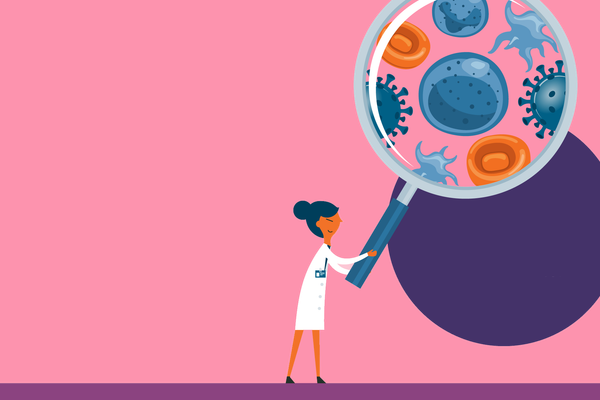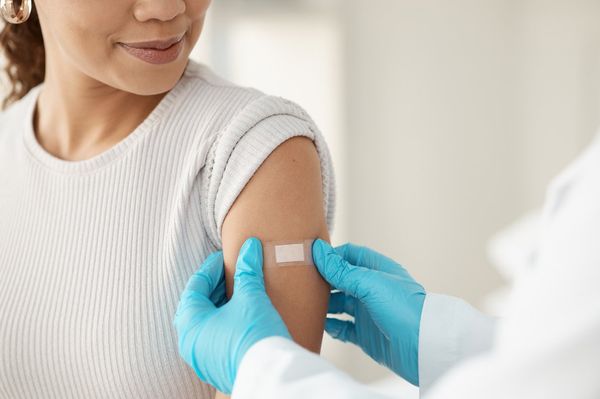This educational resource was created with support from Merck
How Are Vaccines Made? | |
Image of a large family seated around the Thanksgiving dinner table. Mom, at the head of the table, is talking | Mom: I’m so glad we could all be together for Thanksgiving this year! Emily, we’re especially glad to finally meet you. Sam has been gushing about you nonstop since you two started dating. |
Image of a young adult male (her son, Sam) and his girlfriend (Emily) smiling | Sam: You finally have a doctor in the family, Mom! [laughs] Emily is almost done with med school. She’s been working at a vaccine clinic in the city as part of her residency. |
Image of Mom smiling and talking | Mom: How wonderful! I just got my flu shot last week. I just wish I could convince Sam’s dad to do the same. |
Image of Dad, seated at the other end of the table, talking | Dad: I’m sure you’re doing good work, Emily. I’m just not convinced that vaccines are safe. How do they even come up with those things? |
Image of Emily talking | Emily: I totally understand your concern, Mr. Rose. But a lot of work goes into making sure vaccines are safe and effective. I can tell you a little bit about how they’re made if you’re interested? I don’t want to bore everyone. [laughs] |
Image of everyone at the table (except Emily) nodding and smiling | Dad: I’d love to hear from an expert source, Emily — and we’ve got a lot of turkey to get through here! [laughs] Please, go ahead. |
Step 1: Choosing a Target | Emily: Well, first, scientists choose which illness-causing virus or bacteria to target with a vaccine. |
Immune issues Too rare Not serious enough (these words should come in one at a time to match VO) | Some viruses aren’t good targets because of the way they interact with the immune system. Others are too rare, or don’t cause sickness serious enough to need a vaccine. |
Image of adult woman (Aunt Lucy) at table talking | Aunt Lucy: Is that why there’s no vaccine for HIV? Because of the way it affects the immune system? |
Image of Emily nodding HIV with a circle and slash around it | Emily Exactly. Although scientists are working on an HIV vaccine. HIV just isn’t an easy target. |
Step 2: Exploratory Phase | Once a vaccine target has been chosen, the exploratory phase begins. |
Image of a lab filled with a diverse group of scientists bent over microscopes | During this phase, researchers study the way the virus or bacteria affects the immune system. |
Image of Emily talking Visual representation of the process of the imitation invader teaching body to fend off virus/bacteria | The goal is to create an “imitation invader” that teaches our bodies how to fend off the virus or bacteria. That way, our immune system knows what to do when it comes across the real thing. |
Step 3: Pre-Clinical Testing | Once the vaccine is finally developed, pre-clinical testing can start. |
Series of images: first a Petri dish, then a math equation, then a white mouse | During this phase, the vaccine is tested in a few different ways that don’t involve people. |
Image of syringe/needle with red X over it | Unfortunately, not many vaccines make it past pre-clinical testing because they don’t activate the immune system the way they should. |
Sam speaks while he puts more food on his plate | Sam: If a vaccine does show potential, what happens next? |
Step 4: FDA Approval for Clinical Testing | Emily: The next step is getting approval for clinical testing from the FDA. This happens in three phases. |
A diverse group of people lined up to get a vaccine from a lab-coated woman. | During the first phase of clinical testing, small groups of people receive the trial vaccine. |
A larger, diverse group of people lined up to get a vaccine from the same lab-coated woman | During the second phase, the study is expanded to include people who share things in common (like age and health) with the people the vaccine is intended for. |
An even larger diverse group of people lined up to get a vaccine from the same lab-coated woman | During the third phase, the vaccine is given to thousands of people to make sure it’s safe and effective. |
Little boy looks up from eating his meal | Little Boy: How do they make sure a vaccine will work for everyone? |
Image of Emily talking | Emily: Well, clinical trials try to include a lot of different types of people to make sure the vaccine works well for everyone, without dangerous side effects. |
Step 5: Production and distribution Vaccines coming off manufacturing belts and being shipped to and then arriving at doctor’s offices, pharmacies, public health clines | Once a vaccine is finally approved, that’s when it gets mass-produced and distributed to doctor’s offices, pharmacies and public health clinics across the country. |
Image of Dad talking | Dad: That’s the part that worries me. How do we know a vaccine is safe when it’s never been used before? |
Image of checklist with the words “safe” and “effective” checked off | Emily: I hear you, and I think it’s natural to worry about something brand new. But vaccines are based on years and years of research, and a vaccine is never approved by the FDA unless it’s proven to be safe and effective. |
Image of Dad nodding his head and talking | Dad: I must say, you’ve made a convincing case for vaccines, Emily. I have to confess, I didn’t know half of what you just told us. [laughs] |
Image of Emily laughing and talking | Emily : Most people don’t! And there’s a lot of misinformation about vaccines out there. That’s why I’m always willing to talk about them — at least until it’s time for dessert … |
Image of mom, laughing and standing up from table | Mom: Speaking of which, who wants pumpkin pie? |
Image of everyone at table smiling and raising a hand | |
Fade out | |
Image of the dad getting a vaccine. | Want to make sure you and your loved ones are up to date on vaccines? Your healthcare provider, pharmacist or local health department can help. |
www.cdc.gov/vaccines | You can also visit the CDC website to learn more about vaccines and vaccine schedules. |
For more information, please visit HealthyWomen.org | |
This resource was created with support from Merck. | |
- Vaccine Education Program ›
- A Mother’s Journey to Getting Her Children Vaccinated ›
- I Was an Anti-Vaxxer: Here’s What Changed My Mind ›
- Understanding the Different Types of Covid-19 Vaccines ›







